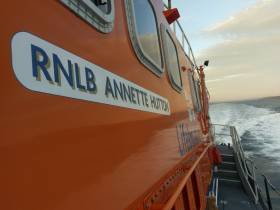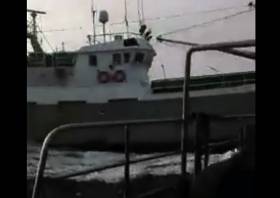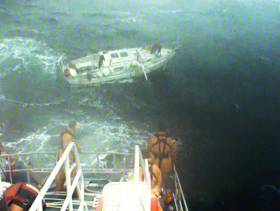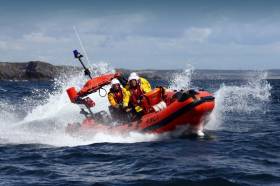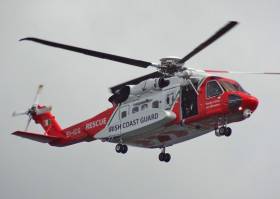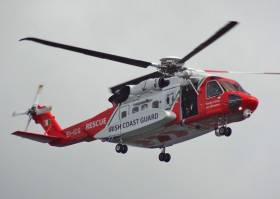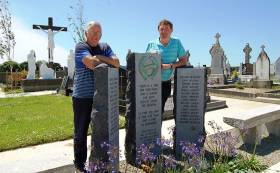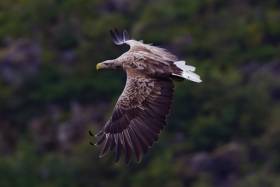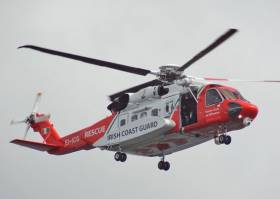Displaying items by tag: west cork
Early Hours Call For Castletownbere Lifeboat To Tow Vessel In Difficulty
#RNLI - Castletownbere RNLI was requested to go to the aid of a 36m vessel with mechanical difficulties north of the Bull Rock off the coast of West Cork on Friday evening (16 December).
The lifeboat, under the command of deputy coxswain Sean Bawn O’Sullivan, was launched within minutes and located the vessel at anchor about one hour later.
The vessel, the Ocean Guardian, was on passage from Castletownbere to Burtonport when it contacted Valentia Coast Guard.
With light winds and a 3-4m swell, RNLI volunteers passed a tow rope to the crew onboard, and the lifeboat took the vessel under tow to Castletownbere.
When off Crow Head some time later, the tow rope broke and had to be reattached. The tow was then completed without further difficulty.
The vessel was berthed alongside the pier in Castletownbere at 2.30am yesterday morning (Saturday 17 December).
West Cork Potter Has Close Call With Spanish Trawler
#Fishing - A small fishing vessel had a close call in West Cork this week when a much larger trawler powered past from Castletownbere with barely any room to spare.
According to the Irish Examiner, the crew of the Celtic Dawn were hailing pots offshore when the Spanish boat approached at speed, and appeared to be taking no evasive action.
Maritime law dictates that vessels such as the Celtic Dawn that are hauling static gear have the right of way, as The Irish Times reports.
And the captain of the smaller boat was not pleased about the situation.
“If it had been foggy, we would have been in trouble,” said Kieran Sullivan.
See video of the near collision below:
#RNLI - The Castletownbere lifeboat Annette Hutton was launched early yesterday morning (Saturday 20 August) when Valentia Coast Guard Radio requested assistance to a yacht in difficulties 45 miles south of Mizen Head in West Cork.
The 8m yacht with one person on board had left the Azores in early August and ran into difficulties in yesterday's severe weather.
The sailor, in his 60s, had been in regular radio contact with Valentia Coast Guard radio until yesterday morning, when his VHF radio was washed overboard. He activated an EPIRB to identify his location, raise the alarm and seek help.
The lifeboat, under the command of coxswain Brian O’Driscoll, was launched at 8am and located the casualty at 10.40am, some 50 miles south-west of Castletownbere. An Irish Coast Guard rescue helicopter was also on scene. Conditions were described as gusting Force 8/9 winds with a 30ft swell.
Amid the challenging sea conditions, the yacht was taken under tow and the lifeboat proceeded slowly to Castletownbere. Early into the tow, the lifeboat crew became concerned about the wellbeing of the sailor and the crew managed to transfer him to the lifeboat.
With the damaged yacht in tow, the lifeboat returned to Castletownbere at 8.30pm, having been at sea for 12-and-a-half hours.
Last night the sailor thanked the Castletownbere lifeboat and all involved for "saving his life", saying: "Only for the lifeboat, things would have ended up very badly today."
Commenting on the callout, Castletownbere RNLI lifeboat operations manager Tony O’Sullivan added: "The coxswain and crew are to be complimented on today’s rescue – they demonstrated skill, seamanship and endurance during what was a long and challenging day."
Union Hall Lifeboat Brings 15 Kayakers To Safety Off Castlehaven
#RNLI - A group of kayakers were brought to safety on Thursday night (18 August) by Union Hall RNLI after they got into difficulty during a night-time kayaking expedition off Castlehaven in West Cork.
The alarm was raised by one of the kayakers after two of the party became separated and the group requested assistance to make their way back to shore.
Union Hall RNLI's inshore lifeboat was launched at 10.45pm and proceeded to the scene, where they learned that the two kayakers originally thought missing had made it to safety on shore and the rest of the group requested assistance to get back to land.
It was decided to take the group off their kayaks and bring them onto the lifeboat before bringing them the short distance to Reen Pier.
The 15 people were helped onboard the Atlantic 85 lifeboat while their kayaks were towed back to shore.
"This was a large group for our inshore lifeboat to assist and our volunteer crew did well in ensuring that everyone was taken onboard quickly and safely," said Union Hall RNLI lifeboat operations manager John Kelleher.
"The weather conditions were challenging for the lifeboat crew to get from their base in Union Hall over to Castlehaven but thankfully conditions on scene were much calmer.
"With the call for help coming in quite early and the lifeboat crew on scene quickly, we were able to get the situation under control in a short time with everyone accounted for and safely brought ashore."
Deceased Fisherman Recovered Off West Cork Is Named
#WestCork - The body of a fisherman whose body was recovered off West Cork yesterday morning (Tuesday 16 August) has been named as Michael O'Brien of Ballydehob, according to The Irish Times.
As previously reported on Afloat.ie, the alarm was raised on Monday evening (15 August) after the 69-year-old failed to return to Schull from a solo fishing trip. His empty punt was found a short time later in Long Island Bay.
After the search resumed yesterday morning, a local boat located O'Brien's body in the water west of Schull off Ballydevlin in an area known locally as Amsterdam Rocks.
The Irish Times has more on the story HERE.
Search Ongoing For Fisherman Off West Cork
#Missing - The search resumed off West Cork this morning (Tuesday 16 August) for a man in his 60s who failed to return to Schull from a solo fishing trip yesterday evening, as The Irish Times reports.
RNLI lifeboats from Baltimore were joined by local fishermen and the Irish Coast Guard's Shannon-based helicopter Rescue 115 to sweep the area where the man's punt was found in Long Island Bay around 8.30pm.
The Irish Times has more on the story HERE.
Coastal Community Commitment – Podcast
There are moments and scenes which stand out in your mind. Stamped on mine is the day I went to a coastal village in West Cork and there, on the edge of a cliffside near Barryroe, close to Courtmacsherry Harbour, I saw the remains of a long-abandoned fishing family’s home, where two sons had died in the biggest sea battle of World War One – the Battle of Jutland on the thirty-first of May 1916. A short distance further up the same cliffside from that house, I was shown the home of another family whose son had died in the same battle. And, amazingly, in the parish of Barryroe, six men from the village had died in that sea battle, fought by a hundred thousand sailors in 250 ships of the British and German Navies. Eight thousand of those sailors were killed, including the six men from this village in West Cork. Another 29 sailors from Barryroe survived.
The interest of coastal communities in their history and culture, their pride in their heritage are impressive and are well underlined in this edition of my maritime programme, THIS ISLAND NATION, (click below for podcast) in the process of producing which I am fortunate to meet such communities.
In this edition I meet people from Courtmacsherry and Barryroe on the West Cork coastline and hear how they have researched and, as a result honoured, the amazing linkage between the area and the biggest sea battle of World War One – the Battle of Jutland, which is also described as the biggest sea battle ever. The statistics from it are, in terms of human destruction, terrible.
To walk into Lislevane Cemetery in Barryroe and see the memorial to those who fought and died at the Battle of Jutland is an emotional experience.
Sea Eagle Fledges In Bantry Bay
#SeaEagle - West Cork was witnessed its first sea eagle fledging in more than 125 years, as The Irish Times reports.
Local birdwatchers have been observing the young white tailed eagle since it left its nest on Garnish Island in Bantry Bay a fortnight ago.
The fledgling marks the first success for the seabird species in the county since a number of Norwegian birds were released in Killarney as part of a sea eagle reintroduction programme between 2007 and 2011.
The Irish Times has more on the story HERE.
Coastguard Airlifts Cliff Fall Casualty On West Cork Coast
#Coastguard - Shannon's Irish Coast Guard helicopter flew to the rescue of a man who survived a 21-metre fall off a sea cliff in West Cork yesterday morning (Monday 7 March).
According to the Irish Examiner, Rescue 115 was tasked along with the Toe Head coastguard unit to attend to the man who was spotted at the base of the steep cliffs at Sandy Cove near Castletownshend.
Both were on scene within 20 minutes of the arrival of the ambulance service, who treated the casualty before he could be safely winched on board the helicopter for transport to Cork University Hospital, receiving further treatment for hypothermia.
It's thought that conditions on the popular cliff path above were rendered unstable after recent heavy rains.
In other coastguard rescue news, Sligo's Rescue 118 was involved in the medevac of an ill crewman from a fishing boat west of Hags Head in Co Clare.
The foreign national, aged 30, complained of abdominal pains before he was flown from the trawler Arkh Angel to University Hospital Galway for treatment, as Galway Bay FM reports.
Schull Marina Project Needs Funding – Former Cork Mayor
Planning permission for a 235–berth marina is due to run out in 2017. General Election Candidate and former Mayor of Cork Cllr Alan Coleman has claimed that funding to get the marina and pier extension project in Schull up and running must be a priority for the next government in a report in the West Cork Times.
The €6million project requires €2.5 million Government funding, Coleman says.
Schull Harbour Sailing Club based in the picturesque harbour that is part of the Wild Atlantic Way says 'If the funding can beorganised this could be a major advance for marine activity around Schull and West Cork'.
Coleman claims the West Cork town 'has been let down by the present government despite three government TDs in West Cork'.
“This marina can be a huge attraction to the area to broaden tourist season and make Schull and the Mizen a destination of choice, says Coleman.
“I have seen the huge economic benefit of investing in three marinas in Kinsale and it has sustained a longer season and made the area more attractive for visitors. A more vibrant tourist season will make the rural economy more sustainable' he said.
More on this story from West Cork Times here.


























